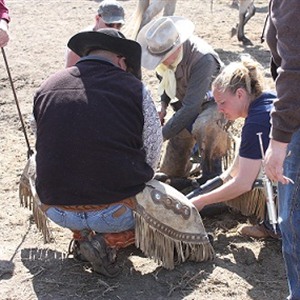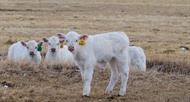Working Ranch Magazine tell us - Value the Vaccination - This is one procedure you don’t want to mess up
Sat 24 Mar, 2012
by Loretta Sorenson of Working Ranch Magazine
Injecting vaccine into a calf doesn’t necessarily mean the animal receives maximum protection from disease. At numerous points between when the vaccine leaves the supplier and when it enters the animal, quality and effectiveness of the shot can be reduced if it’s not handled carefully. Terry Todd, licensed veterinarian and Cohagen, MT, rancher says compromised vaccine can’t stimulate the necessary level of antigens in an animal.
“The vaccine has to trigger production of antibodies and memory cells that bring immunity to a sufficient level,” Todd says. “If immune response isn’t strong enough, or if a calf experiences enough stress and exposure to disease, that threshold of protection can be breached. That’s why you want to keep modified live viruses refrigerated, cool and out of sunlight. Every exposure to heat and sunlight reduces vaccine effectiveness.”
Todd, who no longer practices veterinary medicine but maintains his veterinary license, says most vaccines, at best, protect 90 percent of a calf crop. Some vaccine protection rates drop as low as 60 percent.
“That’s why it’s so important to do everything you can to make the most of that vaccine’s immune response,” he says. “A common mistake made at branding time is thinking anyone can administer vaccine. Actually, it takes someone who’s very careful in handling the vaccine, knows how to assess the quality of the needles they’re using, and has a good grasp of how and where to inject the vaccine. The most important thing that happens at branding time is giving vaccinations.”

Photo by Malloree Barnes
Diana McCoy of Cross M Ranch, located 12 miles up Little Dry Creek in eastern Montana, has developed a reputation for guarding the vaccines she administers at her family’s ranch… and even at neighboring brandings. Diana says her practices are grounded in the principles of getting the most out of the investment vaccinations represent.
“My husband Mike and I have always tried to regularly communicate with local veterinarians and pharmaceutical company representatives to learn all we can about procedures like vaccinations,” Diana says. “We want our cattle to be as naturally healthy as possible. From the time we pick up our vaccine ‘til we’re ready to give the shots, we make sure it’s in a cooler with ice packs so it’s cold and stored out of the sunlight.”
Works with the veterinarian
Donnie Robertson, Vice President of Marketing at Express Ranches in Yukon, OK, says his company works closely with a veterinarian who handles all their veterinary needs.
“He’s constantly updating us on new techniques, new ways to administer drugs,” Robertson says. “We have a group of young men here who are very knowledgeable about things like vaccines and de-wormers. They’re also very skilled about administering shots and treatments.”
Express Ranches cattle are divided into three segments. Each group is treated according to a specific and consistent herd health program. As part of that regime, Robertson says they practice good animal husbandry, keeping vaccine refrigerated as necessary and using a new, sterile needle for every shot that’s given.
“As many cows as we have and as spread out as we are, it’s not possible to have just one person administer all the shots and treatments,” Robertson says. “When we’re learning a new technique or reviewing new information, all the guys involved in our herd health program learn it together.”
Diana McCoy’s vaccination process at the branding pen starts with a precise plan to not mix the products until she knows the irons are hot and the ropers are ready. As soon as her vaccines are mixed, they start dragging calves.
“We just mix one bottle at a time because we know the active virus in the vaccine begins to die soon after it’s mixed,” Diana says. “We also blend the vaccine gently. If you shake it up too hard, that can reduce quality, too. A careful swirl is all it takes to mix dry ingredients with the liquid portion of the vaccine.”
In their efforts to keep modified live vaccines at peak quality, the McCoys remodeled a cooler that allows Diana to insert vaccination guns into the cool, dark environment in between vaccinations. The McCoys cut 1.25” PVC pipe at a 45-degree angle which allows them to suspend the guns so the needles don’t touch the cooler bottom. Above each PVC pipe is a colored marking so Diana knows which vaccine is in which gun. The PVC pipe is easily removed so the cooler can be cleaned. Cold packs and extra vaccine is placed on top of the tubes inside the cooler, keeping everything cool, in the dark and in one location.
“There are times when a branding is moving fast and there are a lot of calves on the ground. You can’t always make it to the cooler to refill your gun,” Diana says. “To guard against heat and sunlight, I place a bottle of vaccine in a modified insulated vest pocket so it will be in a cool, dark place and ready for refilling the gun on the run.”

It's important to protect your Charolais calves and commercial calves.
Needle savvy
Keeping sharp needles in vaccination guns is another important point for maintaining vaccine quality and effectiveness. Todd notes that there are numerous reasons to avoid using dull needles to administer vaccine.
“If that needle is dull, your calf is going to jump every time you give a shot,” Todd says. “That raises the calf’s stress level, which can reduce vaccine effectiveness. When we were using stainless steel chrome plated needles, we washed them after every branding and they tended to get dull before they were disposed of. Now, with sterile aluminum needles packaged individually, there’s really no reason to use a dull or bent needle for vaccinations. The aluminum needles were never intended to be used over and over.”
Todd recommends that those administering vaccines be aware of the possibility that a needle becomes contaminated. With the flurry of activity surrounding branding, contamination is always a possibility.
“Sometimes the gun is dropped and other things can contaminate that needle. Bacterial infection at the vaccine injection sites results in a pus pocket that surrounds that vaccine,” Todd says. “Not only do you have to lance the abscess if it doesn’t rupture on its own, you’ve walled that vaccine off from the animal’s immune system so it’s basically ineffective. You’ve also damaged the quality of that animal’s carcass. And don’t try to straighten a bent needle. A new one isn’t that expensive and the risk of reducing vaccine effectiveness just isn’t worth it.” Plus, it’s very important to remember a bent needle is prone to break. And breaking one off in the animal is another risk that must be eliminated.
The proper location for injecting the vaccine is in the small triangle on the side of the neck. This minimizes damage to the final carcass and reduces the chances for any mobility problems that might result from vaccinations. If more than one vaccine is being administered, allow for three inches between injections sites on calves and four inches when doing grown animals. This is critical to keep one product from interfering with the other.
Both Todd and Diana recommend using smaller dose vials as the branding and vaccinating activities wind down. Mixing 10-dose vials to finish up the last calves is another way to preserve the quality of the vaccine.
“With killed virus vaccines like blackleg, make sure you shake the vaccine to keep the active ingredients uniformly suspended,” Todd says. “You want to know, when the branding and vaccinating are all done, that you’ve immunized every one of your calves to the point where they have the best possible protection from disease.”
Diana says she keeps in mind the motto she learned growing up: “If a job is worth doing, it’s worth doing it right the first time”.

Newborn Charolais Calf
“If you have questions about how things should be done, ask your pharmaceutical representative. Read, research and ask questions. Pick the brains of those people who have the information you need. Make sure you get the full benefit from your investment in those treatments.”
Thanks to Working Ranch Magazine for allowing us to re-post this article. To read this feature in Working Ranch Magazine, you can contact Working Ranch to subscribe or read it now by following this link: Value of Vaccinations